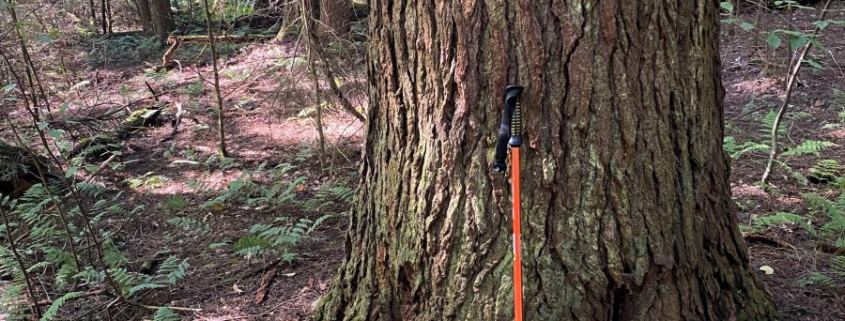Heart’s Content in NW Pennsylvania (Part One)
Venturing into a Pennsylvania Old Growth Forest
September 7, 2021 I hiked and explored the Heart’s Content Scenic Area, a 400-year-old remnant of the original forest that covered the Allegheny Plateau when European settlers arrived in the 18th Century, within the Allegheny National Forest of northwest Pennsylvania. This Post focuses on the origin and species composition of this ancient forest, which lies just forty miles west of where I conducted my 1985-86 doctoral research on soil-site relationships in the second-growth Allegheny Hardwoods forest type. I thrilled at returning to these Allegheny Hardwoods. I left a bit of my heart and soul here on the Allegheny Plateau, having spent many months establishing my research design, selecting suitable stands, and conducting extensive sampling and data collection.
I could have lingered far longer than just the morning on Septrember 7, but left time to hike in the nearby Hickory Creek Wilderness, which is second-growth Allegheny Hardwoods, just like my research sites. Because I want to include lots of photos, I won’t burden you with a great deal of text, yet, enough to make my points and offer pertinent observations and reflections.
Four-Century Relic Forest
Signage is excellent at this Registered Natural Landmark.
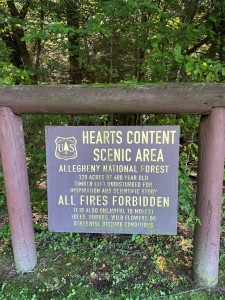
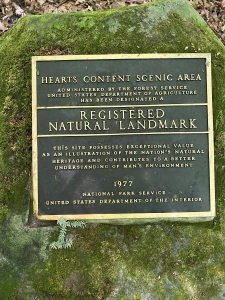
Too often the forest products industry is painted with a broad brush, vilified by those who attribute forest destruction to greedy industrialists. Yet, 100 years ago, leaders in the local lumber industry donated the first 20-acre parcel of this relic forest for preservation. The lumbermen of that period did not strip the original forests as an act of intentional devastation. Instead, they were meeting the young country’s nearly insatiable demand for lumber, charcoal, chemicals, pulpwood, firewood, poles, masts, railroad ties, fenceposts, and…the product list goes on. I worked as a forester 1973-85 in the paper and allied products manufacturing industry. The company, Union Camp Corporation, espoused a deep land ethic and practiced responsible forest stewardship devoutly on its 2.1 million acres of company forests across the six southeastern states.
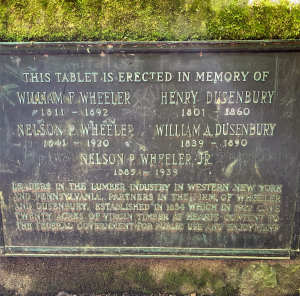
Some unacquainted with the reality of ancient eastern hardwood forests may have an image of vast stands of towering trees with full canopies, dark and shaded understories, and the ground open and free of fallen trees. Such could not be further from the true condition. Picture instead, a major forest disturbance (e.g., widespread blowdown followed by fire) in the late 16th century. Seed-in-place, distributed seed from undisturbed stands nearby, and root and stump sprouting quickly populated the devastated forest. Over the subsequent few years, tens or even hundreds of thousands of seedlings and sprouts occupied each acre. Fierce competition for nutrients, moisture, and sunlight reduced stocking at a predictable pace, until at age 400 years, the stand contains, from my non-empirical observations, not much more than a dozen of the individual 400-year-old trees per acre. The stand today is a jumble of very large standing live trees, dead snags, and large quantities of dead and down woody debris (i.e. logs and tops in various stages of decay). Scattered crown openings left from fallen and dead standing trees yield a patchwork of deep shade, bright overhead lighting, and dappled forest floor sunlight. The Heart’s Content Natural Area is not an unbroken forest of large trees and deep shade.
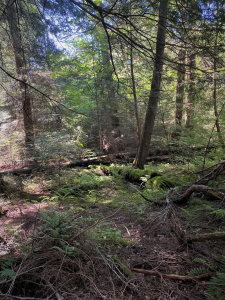
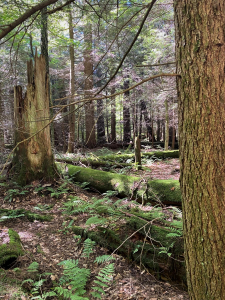
Let’s look at how this forest may have developed over its first century after the major 16th century disturbance.
Ninety Years of Allegheny Hardwood Forest Renewal
Wisely, US Forest Service researchers began a long-term monitoring study on the Tionesta Scenic and Research Natural Area, Allegheny National Forest, in 1928. Note: the entire photo sequence is courtesy of the US Forest Service (Copyright USFS). The forest scientists arranged and oversaw timber harvesting on an old growth forest that year. Cutting was in progress below left. The image below right (1929), taken from the same photo point at exactly the same angle, shows the site at the end of the first growing season post-harvest. Note the proliferation of young seedlings and sprouts.
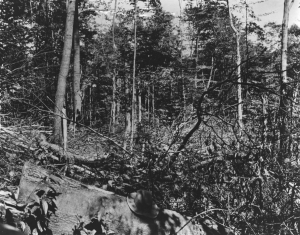
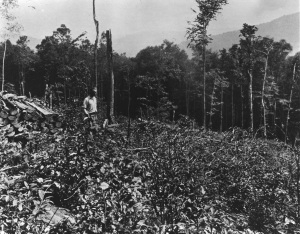
At ages ten and twenty (1937 and 1947) the tens of thousands of stems per acre is transitioning from a nearly impenetrable thicket to a stand of saplings with spacing sufficient for a forester to walk through and measure individuals. I have said in prior Blog Posts that Nature is a meritocracy. The 1937 and 1947 survivors (I am estimating that less than five percent of the tree seedlings/sprouts in the 1929 stand remain at age 20) are stronger, faster growing individuals that simply outperformed those no longer extant. To the victors go the spoils. The competition occurs both within and between species. Affirmative action does not operate in natural systems. There are no offices of ecosystem equity to set quotos nor monitor diversity, inclusion, and equity. Species by species, Nature simply performs her relentless pursuit of sustainable growth and reproduction, generation to generation, among all living creatures…as she has operated for 3.7 billion years.
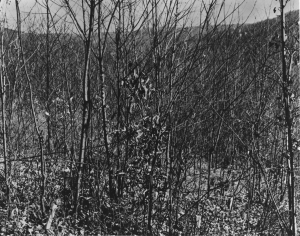
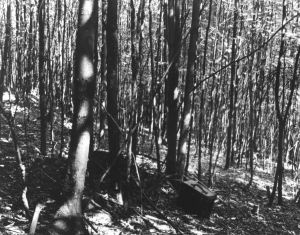
By ages 30 and 40 (1958 and 1968), the forest has changed remarkably, reaching a stage allowing us to more easily follow individual trees from one period to the next. Note the man standing to the left in the 1958 image. The large black cherry tree is reigning over its neighbors, capturing more and more site resources. There are those who today claim in speudo-scientific mainstream publications that the forest is a community of interconnected, caring, and collaborating trees and associated organisms. I encourage readers to carefully study specific stems in this sequence over time. I see no evidence that the survivors give a rip about the stems falling behind, weakening, dying, and tipping to the forest floor.
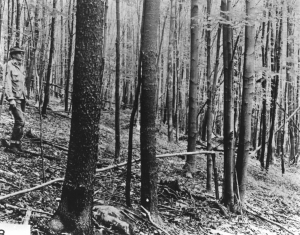
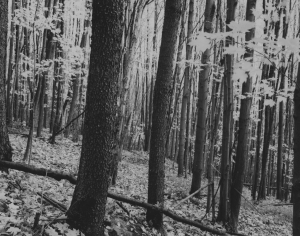
We are now at ages 56 and 60 (1984 and 1988). Our large black cherry continues to thrive; fewer and fewer stems remain. Our seedling thicket has reached a condition such that most casual hikers might think it an undisturbed forest.
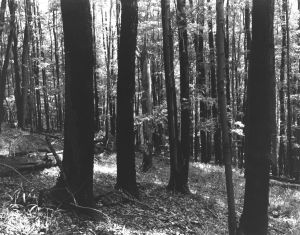
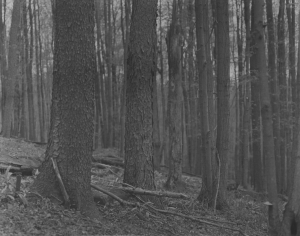
By ages 70 and 80 (1998 and 2008), our dominant cherry is a regal denizen, a magnificent leader of this second growth forest. Dead and down woody debris signals that competition remains fierce. Note that even the distant forest now reveals fewer and fewer stems per acre.
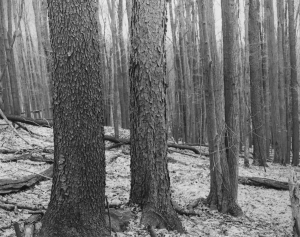
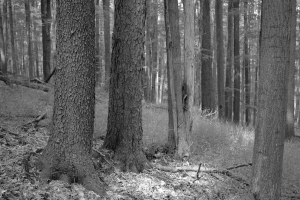
The most recent image (2018) shows a 90-year-old forest, one most observers would term mature. Striking a chord with me, these photos are a reminder that I conducted my doctoral research in 80-90-year-old second growth Allegheny hardwood stands, similar to this one, just 40-50 miles from Tionesta.
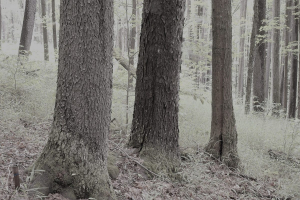
Perhaps there are other long term forest development photo-sequences in the eastern US. If so, I am unaware. I am grateful that Dr. Susan Stout, retired Project Leader at the USFS Warren Forestry Lab and Research Forester Emerita, made these photos available to me. I can think of no better way to impress upon people the dynamic nature of forest ecosystems. Many people, upon entering the 2018 forest, would think that such forests are static and have looked this way for centuries. Today, as I work with landowning entities of all sorts (e.g., the Alabama State Park System, North Alabama Land Trust, and Camp McDowell), I encourage those responsible to begin photo-sequencing special places on their properties.
Stand Composition after 400 Years
I cannot say what the 90-year-old Tionesta forest will look like 300 years from now. Rather than venture into such speculation, let’s examine the Heart’s Content forest as I found it in early September 2021. A hemlock and red oak (each at least three feet in diameter) stand shoulder to shoulder below left. The trees are solid, tall, regal, seeming permanent. What force could possibly topple them? These two ancient sentries may remain standing for decades or longer, yet, I know that even they will ultimately yield to some force of Nature. Nothing in our forests is static; nothing is permanent.
Signaling the impermanence of even the mighty, two like-sized decaying trunks lie side by side below right. Old growth is characterized by large trees and lots of dead and down woody debris, scattered openings, and multi-tiered canopies.
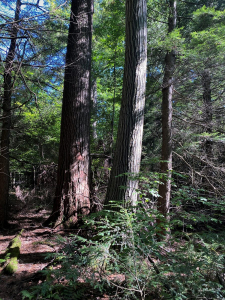
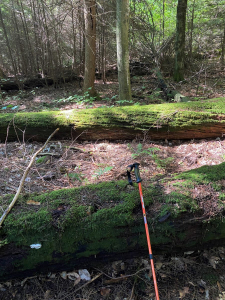
Rather than offer an exhaustive commentary, I present here images of species within the protected forest. Hemlock and white pine account for more than half of the living, standing dead, and down trees…at least fifty percent of the species composition.
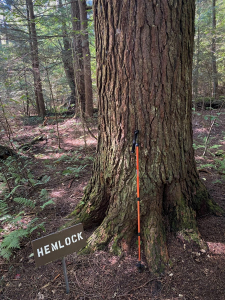
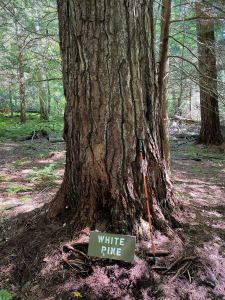
Red maple survives as scattered individuals. The white ash, while still holding its bark, is recently dead from emerald ash borer, a tragic development from New York south to Tennessee, now southward-bound for Alabama to infest and kill our green and white ash.
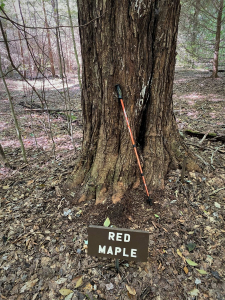
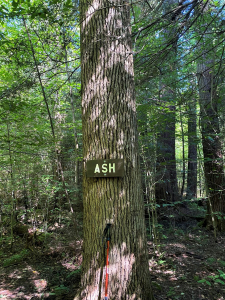
Thanks to interpretive signage, many of these images (yellow birch below left) come pre-labeled! Black birch stands below right.
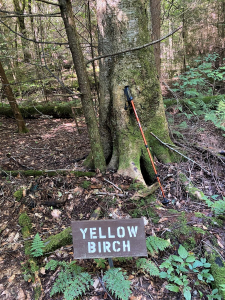
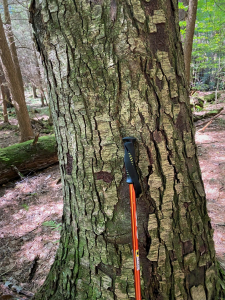
Black cherry and American beech are common.
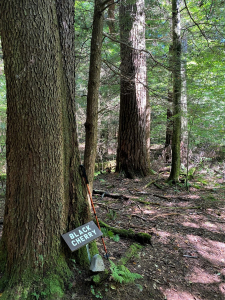
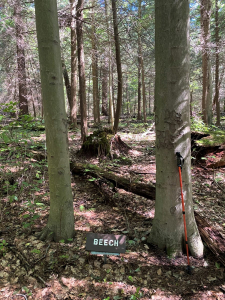
I repeat this image from near the beginning of this Post, this time in simple black and white. It seems appropriate to portray an ancient forest this way, following the B&W images of the 90-year photo sequence.
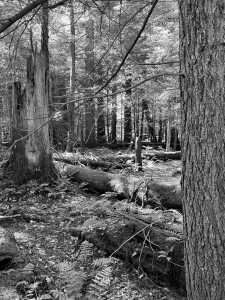
As I said earlier, I could have stayed the entire day, absorbing the essence of this ancient forest. I will draw this Post to closure with a few pertinent John Muir quotes:
Wilderness is a necessity… there must be places for human beings to satisfy their souls.
In every walk with nature one receives far more than he seeks.
The clearest way into the Universe is through a forest wilderness.
Everybody needs beauty as well as bread, places to play in and pray in, where nature may heal and give strength to body and soul.
Nature is ever at work building and pulling down, creating and destroying, keeping everything whirling and flowing, allowing no rest but in rhythmical motion, chasing everything in endless song out of one beautiful form into another.
Thoughts and Reflections
I offer two observations:
- The best way to know a forest is to understand its origin and development.
- Muir nailed it: The clearest way into the Universe is through a forest wilderness.
Inhale and absorb Nature’s elixir. May Nature Inspire, Inform, and Reward you!
Note: All blog post images created & photographed by Stephen B. Jones unless otherwise noted. Please circulate images with photo credit: “©2021 Steve Jones, Great Blue Heron LLC. All Rights Reserved.”
Another Note: If you came to this post via a Facebook posting or by an another route, please sign up now (no cost… no obligation) to receive my Blog Post email alerts: http://eepurl.com/cKLJdL
And a Third: I am available for Nature-Inspired Speaking, Writing, and Consulting — contact me at steve.jones.0524@gmail.com
Reminder of my Personal and Professional Purpose, Passion, and Cause
If only more of us viewed our precious environment through the filters I employ. If only my mission and vision could be multiplied untold orders of magnitude:
Mission: Employ writing and speaking to educate, inspire, and enable readers and listeners to understand, appreciate, and enjoy Nature… and accept and practice Earth Stewardship.
Vision:
- People of all ages will pay greater attention to and engage more regularly with Nature… and will accept and practice informed and responsible Earth Stewardship.
- They will see their relationship to our natural world with new eyes… and will understand more clearly their Earth home.
Tagline/Motto: Steve (Great Blue Heron) encourages and seeks a better tomorrow through Nature-Inspired Living!
Steve’s Three Books
I wrote my books Nature Based Leadership (2016), Nature-Inspired Learning and Leading (2017), and Weaned Seals and Snowy Summits: Stories of Passion for Place and Everyday Nature (2019; co-authored with Dr. Jennifer Wilhoit) to encourage all citizens to recognize and appreciate that every lesson for living, learning, serving, and leading is either written indelibly in or is powerfully inspired by Nature.
I began writing books and Posts for several reasons:
- I love hiking and exploring in Nature
- I see images I want to (and do) capture with my trusty iPhone camera
- I enjoy explaining those images — an educator at heart
- I don’t play golf!
- I actually do love writing — it’s the hobby I never needed when my career consumed me
- Judy suggested my writing is in large measure my legacy to our two kids, our five grand kids, and all the unborn generations beyond
- And finally, perhaps my books and Blogs could reach beyond family and touch a few other lives… sow some seeds for the future


All three of my books (Nature Based Leadership; Nature-Inspired Learning and Leading; Weaned Seals and Snowy Summits) present compilations of personal experiences expressing my (and co-author Dr. Wilhoit for Weaned Seals and Snowy Summits) deep passion for Nature. All three books offer observations and reflections on my relationship to the natural world… and the broader implications for society. Order any and all from your local indie bookstore, or find them on IndieBound or other online sources such as Amazon and LifeRich.

